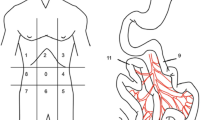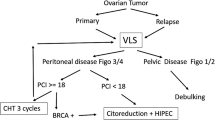Abstract
Background
Complete macroscopic cytoreduction in patients with peritoneal carcinomatosis (PC) is the basic requirement for long-term survival. Diagnostic laparoscopy (DL) can be difficult and of limited clinical value secondary to postoperative or tumor-induced adhesions. The aim of this study was to evaluate the role of DL in patients with prior surgery and PC.
Methods
The database of the surgical department of the University Medical Center of Regensburg was reviewed (9/2010–10/2014) selecting for DL in patients with PC. The operative report had a standardized format allowing for the determination of the extent of the intra-abdominal visible area and the extent of tumor on the surface of the small intestine. For the classification we used our own developed score.
Results
DL was performed in 102 patients. The complete abdominal cavity was evaluable in 48%. At least two quadrants and the largest part of the small intestine could be assessed in 70%. 37% of the patients had massive tumor manifestation on the small intestine or its mesentery. PCI (Peritoneal Cancer Index) could not be calculated in 71% of the patients due to incomplete visualization of the abdominal cavity and/or multiple tumor manifestations on the small intestine. 54% of patients were classified as non-resectable and 85% who seemed suitable for cytoreductive surgery underwent a CCR-0 resection and HIPEC.
Conclusions
In spite of prior surgery and PC, DL is frequently possible and a useful tool to define the extent of tumor spread. Lots of patients can be prevented from needless open laparotomy. The extent of tumor involvement of the small intestine seems to be more relevant than calculation of the PCI to determine the potential for complete resection. Therefore, in the presence of adhesions, inspection of the complete abdominal cavity does not offer added clinical benefit and further adhesiolysis can be avoided.



Similar content being viewed by others
References
Bakrin N, Bereder JM, Decullier E et al (2013) Peritoneal carcinomatosis treated with cytoreductive surgery and hyperthermic intraperitoneal chemotherapy (HIPEC) for advanced ovarian carcinoma: a French multicentre retrospective cohort study of 566 patients. Eur J Surg Oncol 39(12):1435–1443
Esquivel J, Piso P, Verwaal V et al (2014) American Society of Peritoneal Surface Malignancies opinion statement on defining expectations from cytoreductive surgery and hyperthermic intraperitoneal chemotherapy in patients with colorectal cancer. J Surg Oncol 110(7):777–778
Glehen O, Gilly FN, Boutitie F et al (2010) Toward curative treatment of peritoneal carcinomatosis from nonovarian origin by cytoreductive surgery combined with perioperative intraperitoneal chemotherapy: a multi-institutional study of 1290 patients. Cancer 116(24):5608–5618
Glehen O, Mithieux F, Osinsky D et al (2003) Surgery combined with peritonectomy procedures and intraperitoneal chemohyperthermia in abdominal cancers with peritoneal carcinomatosis: a phase II study. J Clin Oncol 21(5):799–806
Spiliotis J, Halkia E, Lianos E et al (2015) Cytoreductive surgery and HIPEC in recurrent epithelial ovarian cancer: a prospective randomized phase III study. Annal Surg Oncol 22(5):1570–1575
Sugarbaker PH (2006) New standard of care for appendiceal epithelial neoplasms and pseudomyxoma peritonei syndrome? Lancet Oncol 7(1):69–76
Verwaal VJ, van Ruth S, de Bree E et al (2003) Randomized trial of cytoreduction and hyperthermic intraperitoneal chemotherapy versus systemic chemotherapy and palliative surgery in patients with peritoneal carcinomatosis of colorectal cancer. J Clin Oncol 21(20):3737–3743
Glehen O, Gilly FN (2003) Quantitative prognostic indicators of peritoneal surface malignancy: carcinomatosis, sarcomatosis, and peritoneal mesothelioma. Surg Oncol Clin N Am 12(3):649–671
Elias D, Lefevre JH, Chevalier J et al (2009) Complete cytoreductive surgery plus intraperitoneal chemohyperthermia with oxaliplatin for peritoneal carcinomatosis of colorectal origin. J Clin Oncol 27(5):681–685
Jacquet P, Sugarbaker PH (1996) Clinical research methodologies in diagnosis and staging of patients with peritoneal carcinomatosis. Cancer Treat Res 82:359–374
Portilla AG, Shigeki K, Dario B, Marcello D (2008) The intraoperative staging systems in the management of peritoneal surface malignancy. J Surg Oncol 98(4):228–231
Mohkam K, Passot G, Cotte E et al (2016) Resectability of peritoneal carcinomatosis: learnings from a prospective cohort of 533 consecutive patients selected for cytoreductive surgery. Ann Surg Oncol 23(4):1261–1270
Klumpp B, Schwenzer NF, Gatidis S et al (2014) Assessment of relapse in patients with peritoneal carcinomatosis after cytoreductive surgery and hyperthermic intraperitoneal chemotherapy using F-18-FDG-PET/CT. RoFo 186(4):359–366
Esquivel J, Chua TC, Stojadinovic A et al (2010) Accuracy and clinical relevance of computed tomography scan interpretation of peritoneal cancer index in colorectal cancer peritoneal carcinomatosis: a multi-institutional study. J Surg Oncol 102(6):565–570
Jacquet P, Jelinek JS, Steves MA, Sugarbaker PH (1993) Evaluation of computed tomography in patients with peritoneal carcinomatosis. Cancer 72(5):1631–1636
Koh JL, Yan TD, Glenn D, Morris DL (2009) Evaluation of preoperative computed tomography in estimating peritoneal cancer index in colorectal peritoneal carcinomatosis. Ann Surg Oncol 16(2):327–333
Rivard JD, Temple WJ, McConnell YJ, Sultan H, Mack LA (2014) Preoperative computed tomography does not predict resectability in peritoneal carcinomatosis. Am J Surg 207(5):760–764. (Discussion 764–765).
Cotte E, Passot G, Gilly FN, Glehen O (2010) Selection of patients and staging of peritoneal surface malignancies. World J Gastrointest Oncol 2(1):31–35
Pomel C, Appleyard TL, Gouy S, Rouzier R, Elias D (2005) The role of laparoscopy to evaluate candidates for complete cytoreduction of peritoneal carcinomatosis and hyperthermic intraperitoneal chemotherapy. Eur J Surg Oncol 31(5):540–543
Valle M, Garofalo A (2006) Laparoscopic staging of peritoneal surface malignancies. Eur J Surg Oncol 32(6):625–627
Garofalo A, Valle M (2003) [Staging videolaparoscopy of peritoneal carcinomatosis]. Tumori 89(4 Suppl):70–77
Author information
Authors and Affiliations
Corresponding author
Ethics declarations
Disclosures
Drs. Philipp von Breitenbuch, Thomas Boerner, Tonia Jeiter, Pompiliu Piso, and Hans J. Schlitt have no conflicts of interest or financial ties to disclose.
Rights and permissions
About this article
Cite this article
von Breitenbuch, P., Boerner, T., Jeiter, T. et al. Laparoscopy as a useful selection tool for patients with prior surgery and peritoneal metastases suitable for multimodality treatment strategies. Surg Endosc 32, 2288–2294 (2018). https://doi.org/10.1007/s00464-017-5923-0
Received:
Accepted:
Published:
Issue Date:
DOI: https://doi.org/10.1007/s00464-017-5923-0




